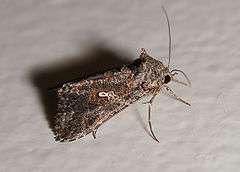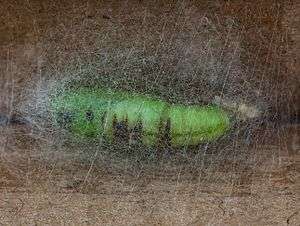Cabbage looper
| Cabbage looper | |
|---|---|
 | |
| Scientific classification | |
| Kingdom: | Animalia |
| Phylum: | Arthropoda |
| Class: | Insecta |
| Order: | Lepidoptera |
| Family: | Noctuidae |
| Tribe: | Argyrogrammatini |
| Genus: | Trichoplusia |
| Species: | T. ni |
| Binomial name | |
| Trichoplusia ni (Hübner, 1800–1803) | |
| Synonyms | |
| |
The cabbage looper (Trichoplusia ni) is a member of the moth family Noctuidae. It is found throughout the southern Palaearctic ecozone, all of North America, parts of Africa and most of the Oriental, parts of Europe (primarily South Europe) and Indo-Australian region.[1] In the United Kingdom, where the adult is primarily a (sometimes numerous) immigrant but breeding is rare, the species is also known as the Ni Moth.[2] The name derives from the forewing marking, which resembles the lowercase Greek letter ni.

The caterpillar, a measuring worm, is smooth and pale green with white stripes and is one of a many species called cabbage worm. It is called a "looper" because it arches its body as it crawls, inchworm-style. This species is very destructive to plants due to its voracious consumption of leaves. It is not restricted to cole crops; other plant hosts include tomato, cucumber, thyme, collard greens, and potato.[1][3][4] The adult of the species is a nocturnal brown moth.
Technical description and variation

Forewing grey suffused with olive brownish and dusted with black atoms; lines black, double, filled in with pale lustrous scales; the inner forming two small curves between median vein and vein 1, with some lustrous scales before it; the outer irregularly crenulate, nearly straight, followed by a pale grey band; subterminal line followed by lustrous scaling and preceded by black sagittate marks; a straight pale line before termen followed by a double lunulate line; fringe chequered brown and grey, with dark lunules at base beyond a white line;orbicular stigma narrow, oblique, edged with lustrous; reniform obscure, dark-edged; median area just below median vein dark brown, containing a broad gamma-shaped mark, the top of which is bell-shaped with ochreous centre, black edged, and outlined in silvery, attached to an oval silvery tail, sometimes also centred with ochreous; hindwing dull brownish, with dark veins and broad smoky blackish terminal border; the fringe white; in the ab. comma Schultz the stigma below middle forms a y-mark.
Larva yellow green; dorsalline dark, double; subdorsal lines slender; lateral line white, with dark upper edge; spiracles reddish yellow; tubercles black.[5]
Molecular biology

Trichoplusia ni is also used as an expression system in the field of molecular biology. High Five cells from Trichoplusia ni are one of the most commonly used cell lines in eukaryotic protein expression.
Resistance to Bacillus thuringiensis insecticidal proteins
"T. ni" is a polyphagus insect that has exhibited resistance to the Bt topical formulation Dipel(R) in Canadian greenhouses.[6] Resistance to the Bt endotoxin Cry1Ac of this population was determined to be autosomal and incompletely recessive.[7] Biochemical analysis of putative toxin receptors indicated an alteration of expression for two APN midgut receptors, with resistant individuals having a downregulation of APN1 and upregulation of APN6 compared to their susceptible counterpart.[8] However, molecular analysis has not linked the APN gene with resistance and instead has identified the gene of ABCC2 with resistance.[9] It is still to be determined what role ABCC2 plays in the mode of action for Bt resistance. The alteration of expression of APNs and the linkage of ABCC2 with Bt resistance could be artifacts of the initially isolated population and may not have any role in the resistant mechanism.
References
- 1 2 "Cabbage looper". Simplykitchengarden.com. Retrieved 2013-07-08.
- ↑ Waring, P., M. Townsend & R. Lewington, 2003. Field Guide to the Moths of Great Britain and Ireland. British Wildlife Publishing, Rotherwick.
- ↑ Fauna Europaea
- ↑ Robinson, G. S., P. R. Ackery, I. J. Kitching, G. W. Beccaloni & L. M. Hernández (2010). "Search Results for Trichoplusia ni". HOSTS - A Database of the World's Lepidopteran Hostplants. London: Natural History Museum.
- ↑ Seitz, A. Ed., 1914 Die Großschmetterlinge der Erde, Verlag Alfred Kernen, Stuttgart Band 3: Abt. 1, Die Großschmetterlinge des palaearktischen Faunengebietes, Die palaearktischen eulenartigen Nachtfalter, 1914
- ↑ Rapid evolution and the cost of resistance to Bacillus thuringiensis in greenhouse populations of cabbage loopers, Trichoplusia ni
- ↑ Inheritance of Resistance to Bacillus thuringiensis Cry1Ac Toxin in a Greenhouse-Derived Strain of Cabbage Looper ( Lepidoptera: Noctuidae )
- ↑ Differential alteration of two aminopeptidases N associated with resistance to Bacillus thuringiensis toxin Cry1Ac in cabbage looper
- ↑ Parallel evolution of Bacillus thuringiensis toxin resistance in lepidoptera
External links
- Lepiforum
- Funet Taxonomy
- cabbage looper on the UF / IFAS Featured Creatures Web site